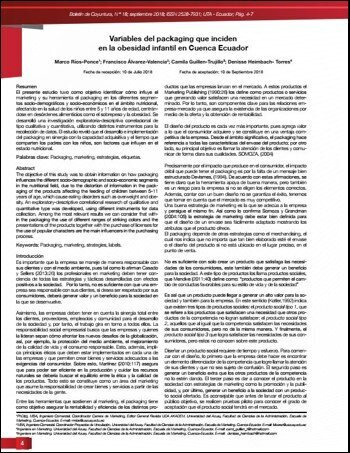Packaging variables that affect childhood obesity in Cuenca Ecuador
Main Article Content
Abstract
The objective of this study was to obtain information on how packaging influences the different socio-demographic and socio-economic segments in the nutritional field, due to the distortion of information in the packaging of the products affecting the feeding of children between 5-11 years of age, which cause eating disorders such as overweight and obesity. An exploratory-descriptive correlational research of qualitative and quantitative type was developed, using different instruments for data collection. Among the most relevant results we can consider that within the packaging the use of different ranges of striking colors and the presentations of the products together with the purchase of licenses for the use of popular characters are the main influencers in the purchasing process.
DOI: https://doi.org/10.31164/bcoyu.18.2018.670
URL: http://revistas.uta.edu.ec/erevista/index.php/bcoyu/article/view/670
Downloads
Article Details

This work is licensed under a Creative Commons Attribution-NonCommercial 4.0 International License.
![]()
The publications of the Boletín de Coyuntura are licensed under a Creative Commons Attribution-NonCommercial 4.0 International License (CC BY-NC 4.0). The Universidad Técnica de Ambato retains the copyright of the published works, and favors and allows the reuse of these, as long as: the authorship and original source of publication is cited, and they are not used for commercial or onerous purposes. The intellectual property of the published articles belongs to the authors.
References
DEVISMES, P. GEVALDÁ, J. (1994). “Packaging: Manual de uso”. Marcombo. Edición Original
Encuesta Nacional de Salud y Nutrición. 2011-2013. Ministerio de Salud Pública. Instituto Nacional de Estadística y Censos.
ETCHART, P. (2016). “Hábitos de consumo de golosinas en niños de 10 a 12 años de edad”. Licenciatura de comercialización. 71 Pp.
KOTLER, P. Roberto, E. (1992). “Marketing social: Estrategias para cambiar la conducta pública”. Ediciones Díaz de Santos, S.A.
MARKETING PUBLISHING. (1990). “El Marketing mix: concepto, estrategia y aplicaciones”. Díaz de Santos. 26 Pp.
MARTÍNEZ, H. (2010). “Responsabilidad social y ética empresarial”. Ecoe Ediciones. 117 Pp.
MENDIVE, D. (2000). “El Marketing social puede ser un instrumento de evangelización.”. El Cid Editor. 40 Pp.
ORGANIZACIÓN MUNDIAL DE LA SALUD (OMS). (2015). “Informe de investigación: publicidad de alimentos dirigida a niños y niñas en la tv argentina”. Fundación Interamericana de Corazón-Argentina.
PURO MARKETING (2016). Recuperado de: http://www.puroMar-keting.com/32/26183/como-packaging-convierte-ninos-consumidores-eli-gen-quieren.html
SÁNCHEZ, A. Piat, G. Ott, R. (2010) “Revista de Posgrado de la VIa Cátedra de Medicina”.
SELLERS, R. Casado, A. (2013). “Introducción al Marketing”. Editorial ECU. 26 Pp.
SOMOZA, E. Gandman, A. (2004). “Packaging: aprehender el envase”. Editorial Nobuko. 105 Pp.
VISSER, R. González, T. Caballero, A. (2009). Prevalencia de obesidad infantil y factores asociados en Aruba. El Cid Editor. 4 Pp.


